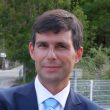Thomas Joindot will give some insights about system architecture and digital continuity at SNCF Réseau, what’s at stake for a railway infrastructure manager and the relationship with the European initiative in the System Pillar.

Thomas JOINDOT
CTO,
SNCF Réseau
Based on an increasing complexity, industrial processes are becoming more vulnerable towards unforeseen disruptive events. The loss of single components can increase the probability of unintentional cascading effects. Potential uncertainties in supply chains can also increase the risk of performance loss within industrial processes. In combination with time variation and the handling of uncertainties, these issues underline the motivation to evaluate and to strengthen the resilience of industrial processes. Within this context resilience is understood as the ability to absorb shocks, to react to a disruption and to return to the initial state through suitable measures. Conceptually resiliency analysis is structured and evaluated in the resilience phases preparation, prevention, protection, response and recovery.
This paper presents a resilience assessment methodology for Airbus’ current industrial system definition. The approach bases on a quantitative time-dependent description of main performance targets that describe key performance indicators of the industrial process. Examples are the output rate, the utilisation or the relation of revenue to the recurrent costs. The developed methodology enables the simulation of the significant process and allows an identification of critical production elements in order to capture neuralgic elements decisive for the overall resilience of the system. Independent of the type of disturbance, the approach is focused on possible consequences and supports which foster the ability to mitigate the loss of performance or to fasten the recovery process.
The application of two use cases demonstrates the strength of the approach and how single resilience phases increase the robustness of the industrial process. The first example focusses on assessing the resilience at production line level, by considering the impact of disturbances on alternative assembly concepts with different degrees of automation. The second example investigates the global industrial system and deals with the evaluation of supply chains, logistics and corresponding risks. The approach identifies solutions how component suppliers, major component suppliers and the final assembly can be resilient designed to cope better against potential disruptions and result in smaller losses.

Kai Fischer
Head of group Robustness & Resilience Analysis,
Fraunhofer EMI
The increasing complexity of newly developed systems requires the usage of advanced design methods and tools, such as Multi-Disciplinary Analysis and Optimisation (MDAO). MDAO processes help to evaluate, explore and optimize a complex system in a fully integrated approach. The issue is however to ensure that these MDAO processes provide appropriate solutions to the system designers, respecting the system requirements and at acceptable cost and computation time. In this paper, we present a Model-Based System Engineering (MBSE)-based methodology for the design of MDAO processes that aims at ensuring the digital continuity from the high-level business and system requirements to the MDAO processes. Once defined, the MDAO process specification is automatically extracted from the MBSE models, and then the process is automatically created in the GEMSEO MDAO framework. This methodology is tested and validated on an academic use case.

Anne Gazaix
Head of MDO Competence Center,
IRT Saint Exupéry
Megatrends of the INCOSE vision 2035 are the explosion of system complexity due to new technologies as well as increasing demand for greater systems capability and efficiency. It predicts also the proliferation of smart systems, meaning systems that are more intelligent, more resilient and more connected. In this context, it is mandatory to break the silos and accelerate stakeholders (value network, disciplines) convergence. Therefore, digital continuity from System of Systems to Physical are critical topics to engineer efficiently systems of tomorrow. After presenting the challenges, this paper highlights the importance of switching from a document based to a model/simulation-based approach with support of adequate methodology like CESAM and Cyber MagicGrid. End-to-end example illustrates the overall process. As a conclusion, the paper opens other digital thread perspective to cover a complete system lifecycle.

Gauthier Fanmuy
Systems Engineering Methodologies & Standards Director,
Dassault Systèmes
In order to meet the architecture analysis requirements of military helicopter, analyse the architecture design requirements based on combat SoS. The process of combat SoS function analysis, equipment function analysis and system function system is proposed. Then according to systems engineering theory, a unified analysis framework is established, including Combat SoS Requirements Analysis Iteration, Equipment SoS Requirements Analysis Iteration, and System Requirements Analysis Iteration. Furthermore, on the basis of current requirements demonstration elements analyse the relationship of mission, system-of-system, system and measures. Based on DoDAF2.0 and MEG, an analysis frame consists of 4 viewpoints and 14 models is established. At last, take the attack helicopter of Country A as an example to verify the feasibility and rationality.

Fang Chen
Requirement Analysis and Systems Engineering engineer,
China Helicopter Research and Development Institute
There has been a recent growth of interest in the application of natural language processing to the domain of requirements engineering. The literature contains both broad reviews, that analyze and categorize the overall state of efforts to date, and papers that detail the use of NLP in a specific context. In this paper we aim to cover the gap in the middle: we investigate particularly one application: extracting structured data from engineering requirements. We first explore rule-based methods and provide a summary on which techniques they rely on. We then discuss how in contrast, newer techniques based on language models could leverage the large requirements datasets that exist in industry. We briefly compare the techniques. We assert that language models present a promising path forward in the use of NLP for requirements engineering.

Johannes Norheim
PhD Candidate,
Massachusetts Institute of Technology
With a rapid growth of the number and importance of the avionics system, it has become more complex and difficult due to the numerous devices and communications during the process of system architecture design and performance evaluation. Traditional design method is based on documentation manually, which is susceptible to changes and documents are hard to maintain and keep consistency when performing performance and safety evaluation. This paper presents a model-based system architecture design and performance evaluation process, and illustrates an example using the above method. Our engineering experience of CA1000 shows that the proposed method can be well applied for developing the avionics system.

Haiyong Dong
System Engineer,
China National Aeronautic Radio Electronics Research Institute
In industry, modeling and simulation are used to enhance productivity, facilitate analysis, and increase profitability. Modeling is used to represent the workflow activities of a prescribed business process operation. But what happens if an unexpected event occurs? This might lead to a deviation of prescribed business operation. In related approaches all solutions are predefined in a way or in another where in other words, most events must be predicted in advance and the others are not caught. This study will introduce a new approach to consider unexpected events occurring in workflow execution. Then, after characterizing the situation, the proposed approach will search a library for compatible solutions to repair the model. Next, the best solution is selected (automatically or manually) and injected in the workflow with respect to an objective function set by experts. Moreover, the library of models can be open to external contribution and benefits from collaborative works.

Charbel Kady
PhD student,
IMT Mines Alès
This study aims at revising the history of knowledge management in consulting firms to propose a survey aimed at designing and implementing a knowledge management model adapted to the needs of modern-day / data-driven consulting firms. First, a four-stage knowledge management activity is examined as per the state-of-the-art context mentioned above. Second, a detailed adaptation of this four-stage model is explicitly proposed for consulting firms in light of Nanoka’s knowledge creation model and other related research. Finally, critical success factors and issues are examined to suggest further research avenues to elaborate our knowledge management model.

Mohammadreza Mirafzal
PhD student,
CentraleSupelec

Olivier Sappin
CEO CATIA,
Dassault Systèmes
More and more companies are embracing the agile paradigm. They want to be seen as agile, and they want to act in an agile way. But becoming agile is easier said than done. « Becoming agile » is a product on its own, sold by many companies. SAFe inc one of those companies that has created a framework for agility that helps companies transform to a Lean-Agile Enterprise. The framework is based on a mixture of experiences and existing literature. In this paper, the essential concepts from SAFe will be compared with theories from organizational and strategic research (OSR). As there is nothing as practical as a good theory, we will try to surface different theoretical perspectives and assumptions behind the practices of SAFe

Geert Haerens
Enterprise Architect,
Engie IT
Flexible production systems rely on utilizing cyber-physical systems (CPS) or the Industrial Internet of Things (IIoT) for managing large numbers of system components, with the goal to automate production processes, optimize resource handling or flexible manufacture products in lot size 1. However, due to heterogeneous components making best possible decisions for themselves, which are distributed throughout the whole value-creation network, describing such system architectures becomes a challenging task. Furthermore, in future manufacturing systems, the integrated development of production systems, smart product designs and manufacturing process is encouraged, because they are dependent from each other. As contemporary frameworks reach their limits while developing flexible production system architectures, novel methodologies need to emerge aiming to deal with the upcoming complexity. Thus, this paper introduces a powerful framework for developing such system architectures by applying a domain-specific-language, a particular process model and automation functionalities, called the RAMI Toolbox. To cope with the complexity, this toolbox makes use of the characteristics originating from the Reference Architecture Model Industrie 4.0 (RAMI 4.0) and applies the concepts of model-based systems engineering (MBSE). In this paper the compilation of the RAMI Toolbox is explained in detail and application examples of flexible production systems are outlined.

Christoph Binder
Researcher,
Fachhochschule Salzburg
As a result of increased complexity of operational theatres (increased density of objects, low observable threats, etc.), increasing sensor cooperation on-board airborne platforms is becoming decisive to maintain a valuable situational awareness, while preventing the adversary to do the same. Instead of relying on sensor-specific technical modes, the Sensor Suite interface relies on a higher level “service” interface, closer to the user’s (being a mission system, a pilot, a UAV operator or another system) operational needs. To execute Services, the Sensor Suite plans and tasks the most relevant sensor actions. Multi-agent system solution, and in particular “Tactical agents”, representing tactical entities in the theatre (volume, areas, objects, etc.) is one relevant solution in order to implement sensor planning and tasking. Two case studies of sensor planning and tasking show that “Tactical agents” offer robust and adaptive solutions when applied to different architectures, taking into account Software component-oriented solutions.

Ludovic Grivault
System Engineer,
Thales
Complex projects with a large scope are challenging. This challenge comes from multiple origins and from multiple phases of development. One of the main challenge of large complex project is managing and maintaining the consistency of the design on the different system levels and between the different contributions from all the actors of the project. Methods, tools and best practices of systems engineering (among others) are dedicated to achieve such a goal. However, there is always room for improvement in our ways of doing it. One example of our need for improvement would be that, because background knowledge of systems engineering can range a lot within the members of a team, team members that are not well versed in systems engineering can be reluctant to invest themselves in methods and tools in which they don’t naturally see the benefit for themselves. Hence we need to make this benefit visible, even if it comes with adaptation of a well structure process. Another example lies in addressing weaknesses from the V-cycle (which is still widely considered as the main go-to approach to perform systems engineering) where the rigidity of the V-cycle when we do not allow uncertainties on hypothesis at a given system level to perform studies at a lower level. Or, the loss of vision the impact of a design decision at low level has on the global performance of the system. That is why, at ArianeGroup, in a frame of a newly starting large complex project we decided to keep on improving on our ways of working. The idea is to organize this project by benefiting from an agile mindset and the SCRUM framework to enable it and from systems engineering best practices such as concurrent engineering, MBSE, … However, even if, from research past, we found that there are synergies for agile organization and systems engineering, those synergies do not naturally tend toward having an optimized reactivity and system consistency. To achieve this synergy we needed a method to create this link between the reactivity and adaptability of an agile mindset, and the management of the consistency and relevancy of the system offered by systems engineering practices. In this context, we took the assumption that the Key Design Driver method (owned by CESAMES and with which we already had some experience on a smaller scale project) could fit this role of a link between systems engineering « classical » activities and agile project development. Thus we initiated, with the support of CESAMES an activity of defining and using the KDD with the idea of being able to: • Manage and maintain consistency on a large complex project • Facilitate common understanding within the team regarding multidisciplinary convergence • Provide a real-time synthetic technical view to customers where they can assess and react to risks, opportunities and priorities The results presented here focus on the first phase of the project (equivalent to a phase 0), the setting up of the KDD, how do we use them both internally and to interface with customers, and how do we plan to use them when scaling up the project. The presentation of those results is accompanied by a discussion on the feedbacks from such an exercise and the lessons learnt for the future of this project and the upcoming projects.

Arthur Schmitt
Co-engineering solution engineer,
ArianeGroup
Engineering practitioners consider non-technical complexity, related to systems under design, to be uneasy to address, due to perceiving it to be outside their expertise. Tackling non-technical complexity requires practitioners to see connections between the complexity and themselves, then be motivated enough to act. Motivation, however, is challenging because complexities must be sufficiently articulated and the practitioners should feel confident to address them. We propose an approach, called 3U, to support engineering practitioners to better perceive and express non-technical complexity problems, reduce cognitive constraints and begin initial solution ideation to become stimulated to address the problems. The approach consists of complexity mapping, relay ideation and bio-inspired analogy creation. We preliminarily evaluate the approach through a workshop and interviews. Workshop participants found the approach particularly valuable in the early period of projects but identified the complicatedness of using bio-inspired analogies. We consider our approach can contribute to enhancing multidisciplinary team collaboration.

Gisela Garza Morales
PhD Candidate,
University of Twente
Research has indicated that systems thinking is primarily developed using experiential learning. This paper reviews the experiential learning pedagogy used, the systems methods taught, and their application by a team of students in SYS 530 Practical Systems Thinking, a graduate-level course taught at Purdue University to a combined population of residential full-time students and online part-time students. The students applied the Viable System Model, Soft Systems Methodology, Critical Systems Heuristics, and various methods for system concept generation and selection to assist the Air Company in reducing the carbon costs associated with the distribution of its product in order to reduce the overall carbon footprint of the company and to make a carbon-negative system more achievable in the future. The paper also reports on the status of efforts at Air after the course concluded that were taken to implement the students’ recommendations and provides updated recommendations.

C. Robert Kenley
Professor of Engineering Practice in Industrial Engineering,
Purdue University

Nick Steinke
Senior Engineering Manager,
Air Company